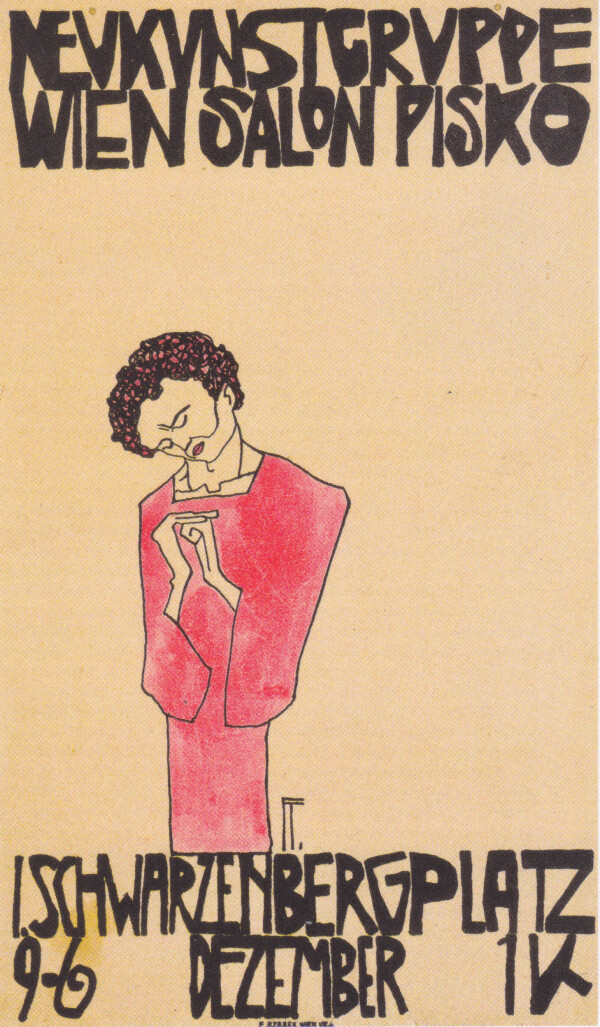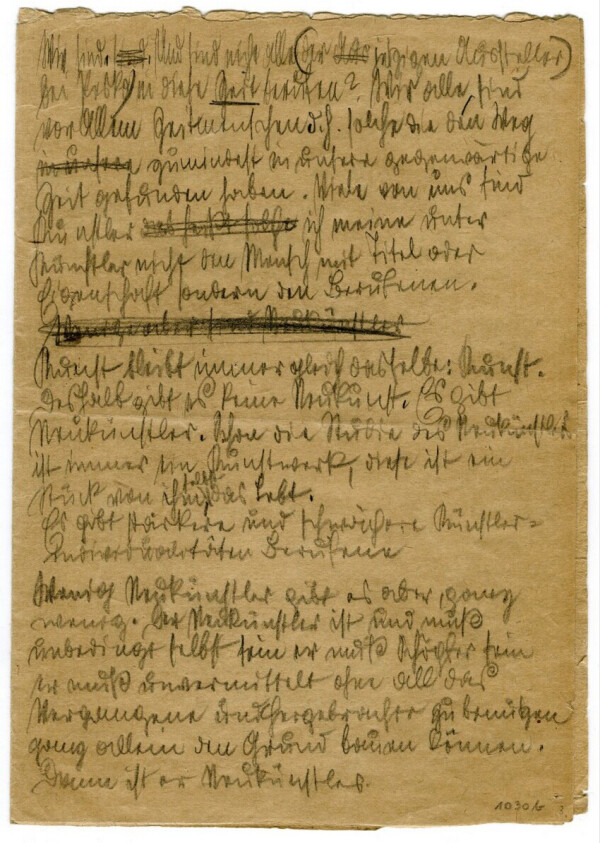Neukunstgruppe

Anton Faistauer: Poster for the first exhibition of the Neukunstgruppe, 1909
© Klimt Foundation, Vienna

Egon Schiele: Manifesto of the Neukunstgruppe, draft essay, sheet 1, front page, 1909
© The ALBERTINA Museum, Vienna
The Neukunstgruppe [New Art Group] was founded in the summer of 1909, aiming at an artistic evolution independent of conservative and traditional currents. Many among the “New Art Foxes” saw Gustav Klimt’s oeuvre as their artistic foundation and point of departure.
Better a “Klimt-Kerl” than a “Griepenkerl.” – The Beginnings
In April 1909, Egon Schiele penned a protest letter with the support of like-minded fellow students. Raising provocative questions, the young students cast the teaching methods practiced at the Vienna Academy of Fine Arts into doubt while calling for a liberal and open educational concept. The chief bone of contention was the specialized class headed by Professor Christian Griepenkerl. Personal resentments between Schiele and Griepenkerl aggravated the situation. This petition eventually led to the threat of expulsion from the academy of the persons involved. Schiele and his comrade-in-arms forestalled this threat by leaving the academy voluntarily. This thus paved the way for the foundation of the Neukunstgruppe. Arthur Roessler observed programmatically:
“But if I can freely choose between an epigone of Griepenkerl and an epigone of Klimt, I decide in favor of Klimt without hesitation, because a ‘Klimt-Kerl’ [note: the German word ‘Kerl’ means ‘fellow’ or ‘lad’ in English] is indeed a different lad than a Griepenkerl.”
“This is why there is no new art. There are new artists.”
In addition to Schiele, the founding members included, among others, Erwin Dominik Osen, Anton Faistauer, Franz Wiegele, Schieles Schwager Anton Peschka, Robin Christian Andersen, Rudolf Kalvach, Felix Albrecht Harta, Oskar Kokoschka, Albert Paris Gütersloh, and Anton Kolig. Schiele himself functioned as president and secretary at the same time.
Apart from the inherent founding purpose of this young formation, the publication “Altkunst – Neukunst” [“Old Art – New Art”] by Ludwig Hevesi, which had appeared that same year, may also have inspired the name.
On 17 June 1909, the young artists committed themselves to presenting an exhibition at the gallery of Gustav Pisko. Moreover, Schiele wrote a founding manifesto, which appeared in June as well. The young group pursued a goal similar to Gustav Klimt’s foundation of the Vienna Secession in 1897: the reformation and renewal of art. Schiele pointed out in his manifesto:
“The New Artist must be himself by all means; he must be the creator; he must carry the very foundation on which he builds directly and solely within himself, without using anything from the past and tradition.”
The proclamation of the Neukunstgruppe appeared in its adapted version in the magazine Die Aktion in 1914.
“Specifically Klimt’s influence is unmistakable.” – The Exhibitions of the “New Art Foxes”
In early December 1909, the Neukunstgruppe finally presented its exhibition at Salon Pisko on Schwarzenbergplatz (No. 14 Lothringerstraße in Vienna’s 3rd District, Landstraße), in the immediate proximity to the site where the “Internationale Kunstschau Wien” had taken place a few months earlier and in which some of the “New Art Foxes” had been represented as well. Next to Friedrich Dornhöffer, director of the Modern Gallery (now Österreichische Galerie Belvedere), the opening was attended by Carl von Reininghaus. Through the show, the young group came into contact with the journalist and art critic Arthur Roessler, who would hence become an important advocate and supporter of the group and especially Egon Schiele. Another presentation followed in early February 1910 at the Club of German Women Artists in Prague. Prague police confiscated fourteen drawings by Schiele, as they were considered indecent. On 7 February, the Montags-Revue aus Böhmen wrote:
“They harbor a great deal of effervescent power, strong volition, and, as can already be seen, ability. These young people still seem somewhat uncertain as they enter the scene; they still appear to be led on the strings their admired masters, Klimt, Hodler, and Goguin [!], wrapped around them. Yet the immediate expression of their own sentiments already makes itself felt […].”
The Prager Abendblatt, on the other hand, failed to recognize innovation and individual features in the seventeen young artists:
“They cannot detach themselves completely from the earthly matter that adheres to them in various guises, even in the gold and silver tinsel à la Klimt.”
What manifests itself in these reviews is that Klimt was a central influence on the intellectual conceptions on display.
In February 1911, the group presented its “Sonderausstellung Malerei und Plastik” [“Special Painting and Sculpture Exhibition”] on the Hagenbund’s premises at Vienna’s Zedlitzhalle (now Zedlitzgasse Office Headquarters and Relay Station, No. 6 Zedlitzgasse, 1st District/Inner City). In January 1912, Albert Paris Gütersloh organized the show “Neukunst Wien” [“Vienna New Art”] at the Budapest Künstlerhaus. In early 1913, some of the “New Art Foxes” were admitted to the League of Austrian Artists, whose president was Gustav Klimt. There followed a show in Budapest aiming at a joint presentation of young and traditional trajectories of contemporary art.
The young formation prevailed as a stable entity only for a short while as it dissolved successively. A major part of the “New Art Foxes” (“Neukunst-Füchse,” a term coined by art historian Josef Strzygowski) continued to be connected by the bond of friendship and exhibited together
Literature and sources
- N. N.: Die Kunst – Der Neukünstler, in: Die Aktion. Wochenschrift für Politik, Literatur und Kunst, 20. Jg., Nummer 4 (1914), S. 428.
- Christian M. Nebehay: Egon Schiele. Von der Skizze zum Bild, Vienna 1989.
- Eva Werth: »Ich weiß, dass es keine moderne Kunst gibt, sondern nur eine - die immerwährend ist.ʼ Der >Neukünstler< Egon Schiele«, in: Anne-Marie Corbin, Friedbert Aspetsberger (Hg.): Schriftenreihe Literatur des Instituts für Österreichkunde. Traditionen und Modernen. Historische und ästhetische Analysen der österreichischen Kultur, Band 19, Innsbruck - Vienna - Bolzano 2008, S. 207-222.
- Egon Schiele Datenbank der Autografen. Biografie (20.04.2020). www.schiele-dokumentation.at/egonschiele.php (04/20/2020).
- Elisabeth Leopold (Hg.): Egon Schiele. Gemälde Aquarelle Zeichnungen, Munich 2020, S. XVI-XXIV.
- Egon Schiele (1890–1918). Biographical Chronology auf: Kallir Reserach Institute: Egon Schiele. The Complete Works Online. egonschieleonline.org/biography (04/20/2020).
- Wilfried Seipel (Hg.): Zeit des Aufbruchs. Budapest und Wien zwischen Historismus und Avantgarde, Ausst.-Kat., Harrach Palace (Vienna), 10.02.2003–22.04.2003, Milan 2003, S. 525–535.
- N. N.: Ausstellung der »Neukunstgruppe Wien 1910« im Klub Deutscher Künstlerinnen, in: Prager Abendblatt, 04.02.1910, S. 8.
- N. N.: Ausstellung der Neukunstgruppe Wien im Klub deutscher Künstlerinnen, in: Montagsblatt aus Böhmen, 07.02.1910, S. 7.
- Josef Stryzygowski: Die Neukunst-Füchse, in: Die Zeit, 01.12.1909, S. 1-2.
- N. N.: Sittlichkeitsretter bei der Prager Polizei, in: Arbeiter-Zeitung, 03.02.1910, S. 4.
- Arthur Roessler: Neukunstgruppe. Ausstellung im Kunstsalon Pisko, in: Arbeiter-Zeitung, 07.12.1909, S. 7-8.
- Neue Freie Presse, 02.12.1909, S. 13.
- Egon Schiele: Manifest der Neukunstgruppe, Variante 1, 06. 1909. Egon Schiele Datenbank der Autografen, ID: 231. www.schiele-dokumentation.at/objekt.php (08/29/2022).
- Salzburg Museum. Faistauer, Schiele, Harta & Co - Malerei verbindet. www.salzburgmuseum.at/ausstellungen/rueckblick/ausstellungen-seit-2015/faistauer-schiele-harta-co-painting-connects-us/ (04/20/2020).
- Tobias G. Natter: Egon Schiele und die Neukunstgruppe, in: Tobias G. Natter (Hg.): Die Tafelrunde. Egon Schiele und sein Kreis, Ausst.-Kat., Upper Belvedere (Vienna), 14.06.2006–24.09.2006, Vienna - Cologne 2006, S. 45-61.

